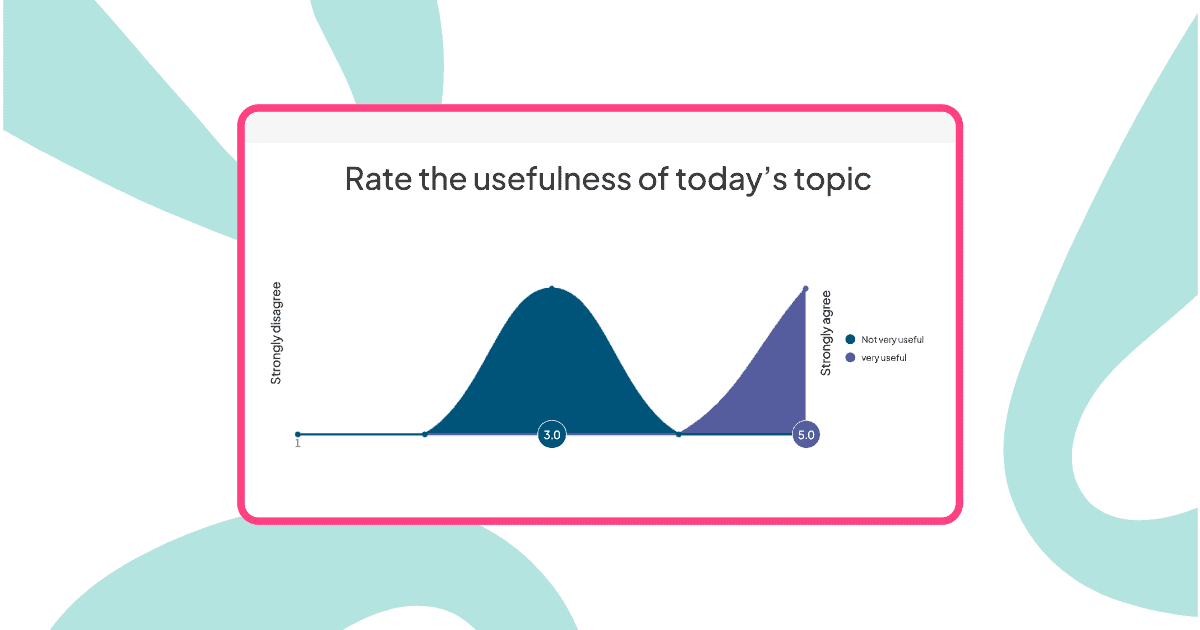Kodi munayamba mwadzifunsapo momwe antchito anu amamveradi za maudindo awo, zopereka, komanso kukhutitsidwa kwa ntchito?
Ntchito yokhutiritsa siilinso ndi malipiro olipidwa kumapeto kwa mwezi. M'nthawi ya ntchito zakutali, maola osinthika, komanso kusintha kwa ntchito, tanthauzo la kukhutitsidwa ndi ntchito lasintha kwambiri.
Nali vuto: kafukufuku wakale wapachaka nthawi zambiri amapereka mayankho otsika, kuzindikira mochedwa, komanso mayankho oyeretsedwa. Ogwira ntchito amawamaliza okha pama desiki awo, osalumikizidwa kuyambira nthawiyo ndikuwopa kuti adziwika. Pamene mukusanthula zotsatira, nkhanizo zakula kapena zaiwalika.
Pali njira yabwinoko. Kafukufuku wokhudzana ndi kukhutitsidwa kwa ntchito zomwe zimachitika pamisonkhano yamagulu, m'mabwalo amtawuni, kapena magawo ophunzitsira amapeza mayankho olondola pakadali pano—pamene chibwenzi chili chapamwamba kwambiri ndipo mutha kuthana ndi zovuta munthawi yeniyeni.
Mu bukhuli, tipereka Mafunso 46 a zitsanzo za mafunso okhutitsidwa ndi ntchito yanu, kukuwonetsani momwe mungasinthire kafukufuku wosasunthika kukhala makambirano opatsa chidwi, ndikuthandizani kulimbikitsa chikhalidwe cha kuntchito chomwe chimalimbikitsa kutanganidwa kwa ogwira ntchito, kuyambitsa zatsopano, ndikukhazikitsa njira yoti zinthu ziyende bwino.
M'ndandanda wazopezekamo
- Kodi Mafunso Okhudza Kukhutitsidwa ndi Ntchito Ndi Chiyani?
- N'chifukwa Chiyani Muyenera Kupanga Mafunso Okhudza Kukhutitsidwa ndi Ntchito?
- Kusiyana Pakati pa Kafukufuku Wachikhalidwe ndi Wophatikizana
- 46 Mafunso a Zitsanzo za Mafunso Okhutitsidwa ndi Ntchito
- Momwe Mungapangire Kafukufuku Wogwira Ntchito Wokhutiritsidwa ndi AhaSlides
- Chifukwa chiyani ma Interactive Surveys Amagwira Ntchito Bwino Kuposa Mafomu Achikhalidwe
- Zitengera Zapadera
Kodi Mafunso Okhudza Kukhutitsidwa ndi Ntchito Ndi Chiyani?
Mafunso okhutitsidwa ndi ntchito, omwe amadziwikanso kuti kafukufuku wokhutitsidwa ndi ogwira ntchito, ndi chida chogwiritsidwa ntchito ndi akatswiri a HR ndi atsogoleri a mabungwe kuti amvetsetse momwe antchito awo akukwaniritsira maudindo awo.
Zili ndi mafunso opangidwa mwaluso opangidwa kuti akwaniritse madera ovuta kuphatikiza malo ogwira ntchito, udindo wantchito, maubwenzi ndi anzawo ndi oyang'anira, chipukuta misozi, mwayi wakukula, moyo wabwino, ndi zina zambiri.
Njira yachikhalidwe: Tumizani ulalo wa kafukufuku, dikirani kuti mayankho abwere, santhulani pakadutsa milungu ingapo, kenaka tsatirani zosintha zomwe zikuwona kuti sizikugwirizana ndi zomwe zidayambitsa.
Njira yolumikizirana: Mafunso omwe alipo amakhalapo pamisonkhano, sonkhanitsani mayankho anthawi yomweyo kudzera m'mavoti osadziwika ndi mawu amtambo, kambiranani zotsatira munthawi yeniyeni, ndipo gwirizanitsani mayankho anthawi zonse pomwe zokambirana zili zatsopano.
N'chifukwa Chiyani Muyenera Kupanga Mafunso Okhudza Kukhutitsidwa ndi Ntchito?
Kafukufuku wa Pew ikuwonetsa kuti pafupifupi 39% ya ogwira ntchito omwe sanadzilembe okha amawona kuti ntchito zawo ndizofunikira kwambiri pakudziwika kwawo. Malingaliro awa amapangidwa ndi zinthu monga ndalama zabanja komanso maphunziro, pomwe 47% ya omwe amapeza ndalama zambiri komanso 53% ya omaliza maphunziro awo akuwonetsa kufunika kwa ntchito yawo. Kulumikizana kumeneku ndikofunikira kwambiri pakukhutitsidwa kwa ogwira ntchito, kupangitsa kuti mafunso okonzedwa bwino okhutitsidwa ndi ntchito kukhala ofunika pakukulitsa cholinga ndi moyo wabwino.
Kupanga mafunso okhutitsidwa ndi ntchito kumapereka zabwino zambiri kwa ogwira ntchito ndi bungwe:
Kumvetsa Mwanzeru
Mafunso enieni amavumbula malingaliro enieni a antchito, kuwulula malingaliro awo, nkhawa zawo, ndi madera okhutira. Mukachitidwa molumikizana ndi njira zoyankhira zosadziwika, mumalambalala kuopa kukuzindikiritsani zomwe nthawi zambiri zimabweretsa mayankho achinyengo pamafukufuku achikhalidwe.
Chizindikiritso cha Nkhani
Mafunso omwe akufunsidwa amatchula zowawa zomwe zimakhudza chikhalidwe ndi chiyanjano-kaya zokhudzana ndi kulankhulana, kuchuluka kwa ntchito, kapena mwayi wakukula. Mitambo ya nthawi yeniyeni imatha kuwona m'maganizo momwe antchito ambiri akuvutikira.
Tailored Solutions
Malingaliro omwe asonkhanitsidwa amalola mayankho mwamakonda anu, kusonyeza kudzipereka kwanu pakukweza ntchito. Ogwira ntchito akaona ndemanga zawo zikuwonetsedwa nthawi yomweyo ndikukambidwa momasuka, amamva kuti akumvedwa m'malo mongofunsidwa.
Kusamvana Kwatsopano ndi Kukonzekera
Kuthana ndi madandaulo otengera zotsatira zamafunso kumakweza chinkhoswe, kumathandizira kuchepa kwa chiwongola dzanja ndikukulitsa kukhulupirika. Kufufuza kwapang'onopang'ono kumasintha zosonkhanitsira mayankho kuchokera muzochita zaudindo kukhala kukambirana kopindulitsa.
Kusiyana Pakati pa Kafukufuku Wachikhalidwe ndi Wophatikizana
| Mbali | Kafukufuku wachikhalidwe | Kafukufuku wogwiritsa ntchito (AhaSlides) |
|---|---|---|
| Nthawi | Kutumizidwa kudzera pa imelo, kumalizidwa kokha | Kumachitika nthawi yamisonkhano |
| Kuyankha anadya | 30-40% pafupifupi | 85-95% ikaperekedwa moyo |
| Kusadziwika | Zokayikitsa-ogwira ntchito amadandaula za kutsata | Kusadziwika kwenikweni popanda malowedwe ofunikira |
| Chinkhoswe | Ndikumva ngati homuweki | Kumva ngati kukambirana |
| Results | Patapita masiku kapena masabata | Kuwonera pompopompo, zenizeni zenizeni |
| Action | Yachedwetsedwa, yachotsedwa | Kukambitsirana pompopompo ndi mayankho |
| mtundu | Mafomu osasunthika | Mavoti amphamvu, mitambo ya mawu, Q&A, mavoti |
Chidziwitso chachikulu: Anthu amachita zambiri pamene mayankho akuwoneka ngati kukambirana osati zolemba.
46 Mafunso a Zitsanzo za Mafunso Okhutitsidwa ndi Ntchito
Nazi zitsanzo za mafunso opangidwa ndi gulu. Gawo lirilonse liri ndi chitsogozo cha momwe angawawonetsere kuti azichita moona mtima komanso kuchitapo kanthu.
Malo Ogwira Ntchito
Mafunso:
- Kodi mungayese bwanji kutonthoza ndi chitetezo cha malo anu antchito?
- Kodi mwakhutitsidwa ndi ukhondo ndi dongosolo la malo antchito?
- Kodi mukuwona kuti chikhalidwe cha ofesi chimalimbikitsa chikhalidwe chabwino cha ntchito?
- Kodi mwapatsidwa zida zofunika komanso zothandizira kuti mugwire bwino ntchito yanu?
Njira yolumikizirana ndi AhaSlides:
- Gwiritsani ntchito masikelo owerengera (nyenyezi 1-5) zowonetsedwa
- Tsatirani ndi mtambo wotseguka: "M'mawu amodzi, fotokozani malo athu antchito"
- Yambitsani mumalowedwe osadziwika kuti ogwira ntchito adziwe moona mtima zakuthupi popanda mantha
- Onetsani zotsatira zonse nthawi yomweyo kuti muyambe kukambirana
Chifukwa chiyani izi zimagwira ntchito: Ogwira ntchito akaona ena akugawana nawo nkhawa zofanana (mwachitsanzo, anthu angapo amayesa "zida ndi zothandizira" ngati 2/5), amamva kuti ndi ovomerezeka komanso ofunitsitsa kufotokoza zambiri pazotsatira za Q&A.
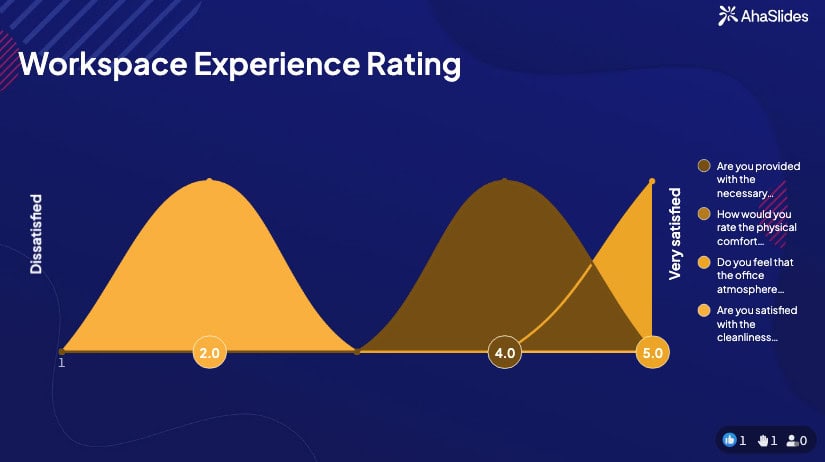
Yesani chivomerezo cha malo antchito →
Udindo ntchito
Mafunso:
- Kodi ntchito yanu yamakono ikugwirizana ndi luso lanu ndi ziyeneretso zanu?
- Kodi ntchito zanu zafotokozedwa momveka bwino ndikudziwitsidwa kwa inu?
- Kodi muli ndi mwayi wopeza zovuta zatsopano ndikukulitsa luso lanu?
- Kodi mumakhutitsidwa ndi kusiyanasiyana komanso zovuta za ntchito zanu zatsiku ndi tsiku?
- Kodi mumaona kuti ntchito yanu imakupatsani cholinga komanso kukwaniritsa?
- Kodi ndinu okhutitsidwa ndi mulingo waulamuliro womwe muli nawo paudindo wanu?
- Kodi mukukhulupirira kuti ntchito yanu ikugwirizana ndi zolinga zonse ndi cholinga cha bungwe?
- Kodi mwapatsidwa malangizo omveka bwino komanso zoyembekeza pazantchito zanu ndi ntchito zanu?
- Kodi mumamva bwanji kuti udindo wanu wantchito umathandizira kuti kampani ikhale yabwino komanso kukula?
Njira yolumikizirana ndi AhaSlides:
- Perekani zisankho za inde/ayi kuti mufunse mafunso omveka bwino (mwachitsanzo, "Kodi ntchito zanu ndi zomveka bwino?")
- Gwiritsani ntchito masikelo owerengera kuti mukwanitse
- Tsatirani ndi Q&A yotsegula: "Ndi maudindo ati omwe mungafune kuwonjezera kapena kuchotsa?"
- Pangani mawu mtambo: "Fotokozani udindo wanu m'mawu atatu"
Ovomereza nsonga: Ntchito yosadziwika ya Q&A ndiyamphamvu kwambiri pano. Ogwira ntchito atha kupereka mafunso monga "Chifukwa chiyani tilibe kudziyimira pawokha popanga zisankho?" popanda mantha kuti adziwike, kulola mamenejala kuti athetse nkhani zadongosolo momasuka.
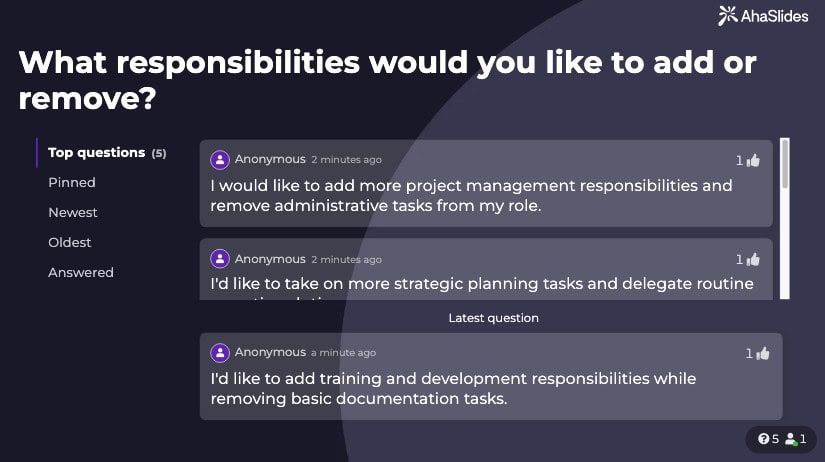
Kuyang'anira ndi Utsogoleri
Mafunso:
- Kodi munganene bwanji za kulumikizana pakati pa inu ndi woyang'anira wanu?
- Kodi mumalandira mayankho olimbikitsa komanso chitsogozo pakuchita kwanu?
- Kodi mumalimbikitsidwa kuti mupereke malingaliro anu ndi malingaliro anu kwa woyang'anira wanu?
- Kodi mukuwona kuti woyang'anira wanu amayamikira zomwe mwapereka ndipo amazindikira khama lanu?
- Kodi mwakhutitsidwa ndi kalembedwe ka utsogoleri ndi kasamalidwe ka dipatimenti yanu?
- Ndi maluso ati a utsogoleri omwe mukuganiza kuti angakhale othandiza kwambiri mu gulu lanu?
Njira yolumikizirana ndi AhaSlides:
- Gwiritsani ntchito masikelo a mavoti osadziwika kuti muyankhe movutikira kwa oyang'anira
- Perekani njira za utsogoleri (zademokalase, kuphunzitsa, zosintha, ndi zina zotero) ndikufunsani antchito omwe angakonde
- Yambitsani Q&A yamoyo pomwe ogwira ntchito atha kufunsa mafunso okhudzana ndi kasamalidwe
- Pangani masanjidwe: "Ndi chiyani chomwe chimakukondani kwambiri mwa oyang'anira?" (Kulumikizana, Kuzindikira, Ndemanga, Kudziyimira pawokha, Thandizo)
Chifukwa chiyani kusadziwika kuli kofunika: Malinga ndi tsamba lanu, akatswiri a HR akuyenera "kupanga malo otetezeka kuti mukambirane moona mtima". Kuvotera kosadziwika bwino m'maholo amatauni kumapangitsa ogwira ntchito kuvotera utsogoleri moona mtima popanda nkhawa zantchito, zomwe zimavuta kuti zitheke motsimikizika.
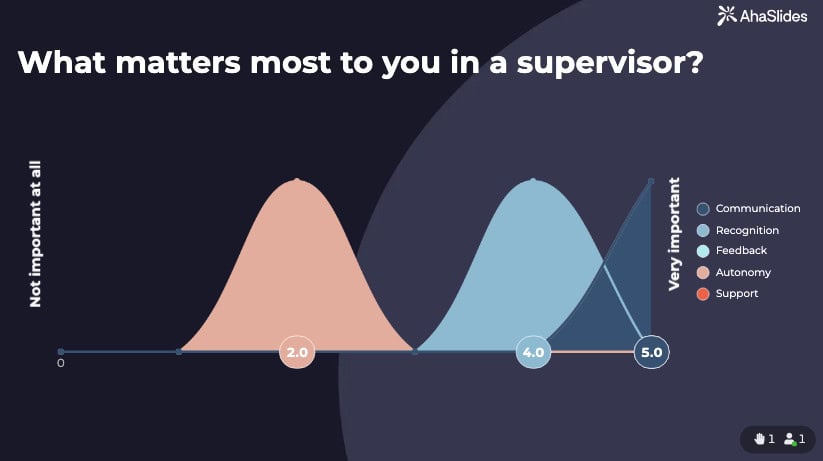
Kukula ndi Kukula kwa Ntchito
Mafunso:
- Kodi mwapatsidwa mwayi wokulitsa luso komanso kupita patsogolo?
- Ndinu okhutitsidwa bwanji ndi maphunziro ndi mapologalamu achitukuko operekedwa ndi bungweli?
- Kodi mukukhulupirira kuti udindo wanu wapano ukugwirizana ndi zolinga zanu zanthawi yayitali?
- Kodi mwapatsidwa mwayi woti mutenge maudindo a utsogoleri kapena ntchito zapadera?
- Kodi mumalandira chithandizo chofuna maphunziro owonjezera kapena kukulitsa luso?
Njira yolumikizirana ndi AhaSlides:
- Kafukufuku: "Ndi chitukuko chanji chaukadaulo chomwe chingakupindulitseni kwambiri?" (Maphunziro a utsogoleri, Luso laukadaulo, Ziphaso, Upangiri, Mayendedwe Otsatira)
- Mawu mtambo: "Kodi mumadziona nokha zaka 3?"
- Mulingo woyezera: "Mumathandizidwa bwanji pakukula kwa ntchito yanu?" ( 1-10 )
- Tsegulani Q&A kuti ogwira nawo ntchito afunse za mwayi wina wachitukuko
Ubwino wa Strategic: Mosiyana ndi kafukufuku wanthawi zonse pomwe izi zimakhala mu spreadsheet, kuwonetsa mafunso okhudza chitukuko cha ntchito kumakhala nthawi yakuwunika kotala kumalola HR kuti akambirane nthawi yomweyo za bajeti yophunzitsira, mapulogalamu aulangizi, ndi mwayi wosuntha wamkati pomwe zokambirana zikuyenda.
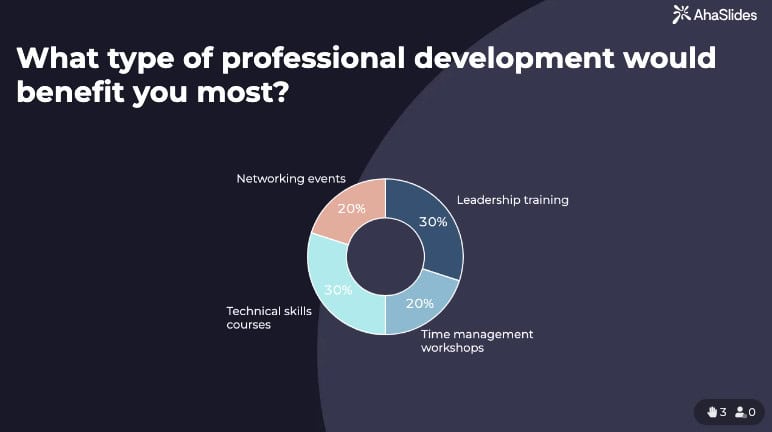
Ndalama ndi Zabwino
Mafunso:
- Kodi mwakhutitsidwa ndi malipiro anu apano ndi chipukuta misozi, kuphatikiza mapindu ochepera?
- Kodi mukuwona kuti zomwe mwathandizira ndi zomwe mwakwaniritsa zalipidwa moyenera?
- Kodi maubwino operekedwa ndi bungwe ndi okwanira komanso oyenera pazosowa zanu?
- Kodi mungawone bwanji kuwonekera ndi chilungamo pakuwunika kwa magwiridwe antchito ndi chipukuta misozi?
- Kodi mwakhutitsidwa ndi mwayi wa mabonasi, zolimbikitsa, kapena mphotho?
- Kodi mwakhutitsidwa ndi ndondomeko ya tchuthi chapachaka?
Njira yolumikizirana ndi AhaSlides:
- Mavoti osadziwika a inde/ayi a mafunso ovuta amalipiro
- Zosankha zingapo: "Ndi maubwino ati omwe ali ofunika kwambiri kwa inu?" (Zaumoyo, Kusinthasintha, Bajeti yophunzirira, Mapulogalamu a Ubwino, Kupuma pantchito)
- Mulingo woyezera: "Kodi malipiro athu ndi abwino bwanji poyerekeza ndi zomwe mwapereka?"
- Mawu mtambo: "Ndi phindu limodzi liti lomwe lingapangitse kuti mukhale wokhutira kwambiri?"
Zofunika kwambiri: Apa ndipamene kafukufuku wosadziwika amawonekeradi. Ogwira ntchito sapereka ndemanga moona mtima pakufufuza komwe kumafunikira zidziwitso zolowera. Khazikitsani mavoti osadziwika m'maholo amatauni, pomwe mayankho amawoneka opanda mayina, amapanga chitetezo m'malingaliro kuti ayankhe zenizeni.
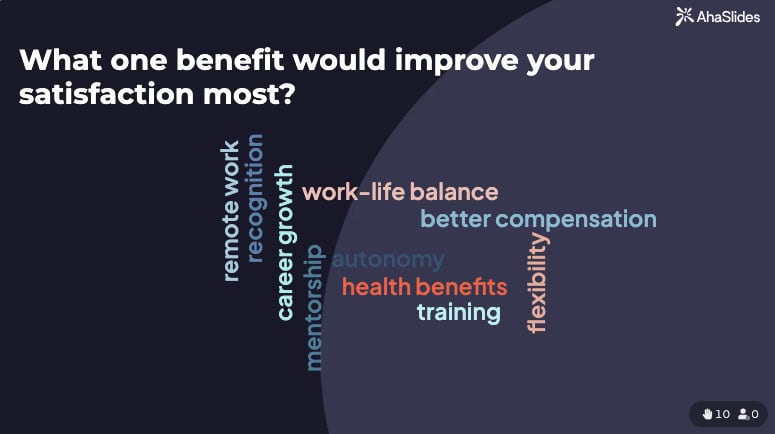
Pangani gawo la ndemanga zanu za chipukuta misozi →
Maubwenzi ndi Mgwirizano
Mafunso:
- Kodi mumathandizana bwino bwanji ndikulankhulana ndi anzanu?
- Kodi mumamva kuyanjana ndi kugwirira ntchito limodzi mu dipatimenti yanu?
- Kodi mwakhutitsidwa ndi kuchuluka kwa ulemu ndi mgwirizano pakati pa anzanu?
- Kodi muli ndi mwayi wolumikizana ndi anzanu ochokera m'madipatimenti osiyanasiyana kapena magulu?
- Kodi ndinu omasuka kufunafuna thandizo kapena upangiri kwa anzanu pakafunika?
Njira yolumikizirana ndi AhaSlides:
- Sikelo zoyezera za khalidwe la mgwirizano
- Mawu mtambo: "Tafotokozani chikhalidwe cha gulu lathu ndi liwu limodzi"
- Zosankha zingapo: "Kodi mumagwira ntchito pafupipafupi bwanji m'madipatimenti onse?" (Tsiku lililonse, mlungu uliwonse, mwezi uliwonse, kawirikawiri, ayi)
- Ma Q&A osadziwika kuti afotokoze zovuta za anthu
Ubwino ndi Kulinganiza kwa Moyo Wantchito
Mafunso:
- Kodi ndinu okhutitsidwa bwanji ndi moyo wapantchito woperekedwa ndi bungweli?
- Kodi mukumva kuthandizidwa mokwanira ndi kampaniyo pakuwongolera kupsinjika ndikukhalabe ndi malingaliro abwino?
- Kodi ndinu omasuka kufunafuna thandizo kapena zothandizira kuthana ndi mavuto anu kapena okhudzana ndi ntchito?
- Kodi ndi kangati mumachita nawo pulogalamu yazaumoyo kapena ntchito zoperekedwa ndi bungwe?
- Kodi mumakhulupirira kuti kampaniyo imaona kuti ndi yofunika komanso imaika patsogolo ubwino wa antchito ake?
- Kodi mumakhutitsidwa ndi malo ogwirira ntchito molingana ndi chitonthozo, kuyatsa, ndi ergonomics?
- Kodi bungwe limakwaniritsa bwanji zosowa zanu pazaumoyo ndi thanzi lanu (mwachitsanzo, maola osinthika, ntchito zakutali)?
- Kodi mukumva kulimbikitsidwa kuti mupumule ndikusiya kugwira ntchito ngati pakufunika kutero?
- Kodi nthawi zambiri mumatopa kapena kupsinjika chifukwa cha zinthu zokhudzana ndi ntchito?
- Kodi ndinu okhutitsidwa ndi maubwino azaumoyo ndi thanzi omwe bungweli limapereka?
Njira yolumikizirana ndi AhaSlides:
- Miyeso yafupipafupi: "Kodi mumamva kupsinjika kangati?" (Sikonse, Mosowa, Nthawi zina, Nthawi zambiri, Nthawizonse)
- Inde/ayi mavoti okhudza chithandizo chaumoyo
- Wotsetsereka wosadziwika: "Voterani kuchuluka kwa kupsa mtima kwanu" (1-10)
- Mawu Cloud: "Ndi chiyani chomwe chingakuthandizireni kukhala ndi moyo wabwino kwambiri?"
- Tsegulani Q&A kuti ogwira nawo ntchito agawane zazaumoyo mosadziwika
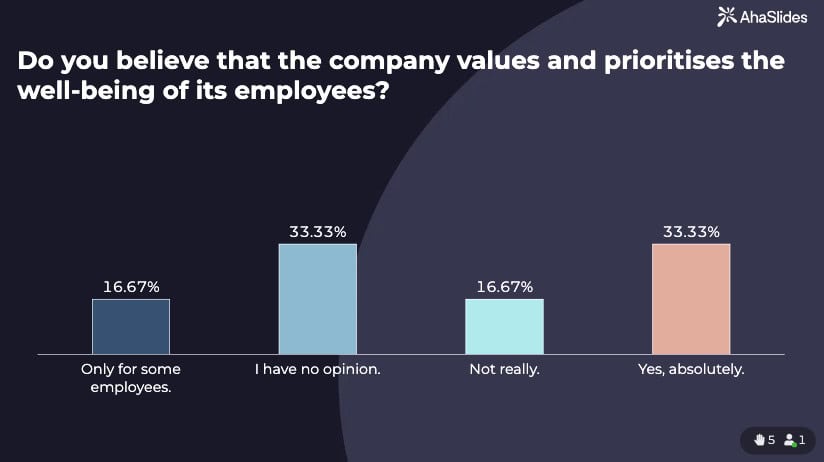
Chifukwa chiyani izi zikufunika: Pepala lanu lolembapo limasonyeza kuti akatswiri a HR amavutika ndi "kukambirana ndi antchito" komanso "kupanga malo otetezeka kuti akambirane moona mtima". Mafunso okhudza thanzi labwino amakhala ovuta - ogwira ntchito amawopa kuwoneka ofooka kapena osadzipereka ngati avomereza kuti akutopa. Kafukufuku wosadziwika bwino amachotsa chotchinga ichi.
Kukhutitsidwa Konse
Funso lomaliza: 46. Pa sikelo ya 1-10, muli ndi mwayi wotani kuti mulimbikitse kampaniyi ngati malo abwino ogwirira ntchito? (Ntchito Net Promoter Score)
Njira yolumikizirana:
- Tsatirani zotsatira potengera zotsatira: Ngati zotsatira zachepa, funsani nthawi yomweyo "Kodi ndi chiyani chomwe tingasinthe kuti tiwongolere magole anu?"
- Onetsani ma eNPS mu nthawi yeniyeni kuti utsogoleri uwone malingaliro posachedwa
- Gwiritsani ntchito zotsatira kuti muyendetse zokambirana zowonekera bwino zakusintha kwa bungwe
Momwe Mungapangire Kafukufuku Wogwira Ntchito Wokhutiritsidwa ndi AhaSlides
Gawo 1: Sankhani Format Anu
Yankho A: Khalani pamisonkhano ya manja onse
- Perekani mafunso ofunika 8-12 m’maholo am’tauni omwe ali kotala
- Gwiritsani ntchito mosadziwika pamitu yovuta
- Kambiranani zotsatira nthawi yomweyo ndi gulu
- Zabwino kwa: Kupanga chidaliro, kuchitapo kanthu mwachangu, kuthetsa mavuto mogwirizana
Njira B: Kuchita zinthu momasuka koma kumachita zinthu mwanzeru
- Gawani ulalo wosonyeza omwe ogwira ntchito angapeze nthawi iliyonse
- Phatikizani mafunso onse 46 opangidwa ndi gulu
- Khazikitsani tsiku lomaliza kuti mumalize
- Zabwino kwa: Kutoleretsa deta, nthawi yosinthika
Njira C: Njira yosakanizidwa (analimbikitsa)
- Tumizani mafunso ovuta 5-7 ngati mavoti odzipangira okha
- Zotsatira zomwe zaperekedwa ndi madandaulo atatu apamwamba amakhala pamsonkhano wotsatira wamagulu
- Gwiritsani ntchito Q&A yamoyo kuti mulowe mozama muzovuta
- Zabwino kwa: Kutenga nawo mbali kwakukulu ndikukambirana kwatanthauzo
Gawo 2: Konzani Kafukufuku Wanu mu AhaSlides
Zomwe mungagwiritse ntchito:
- Mawerengedwe masikelo kwa milingo yokhutiritsa
- Zisankho zingapo kwa mafunso okonda
- Mitambo yamawu kuwona mitu yodziwika bwino
- Tsegulani Q&A kuti ogwira ntchito afunse mafunso osadziwika
- Mawonekedwe osadziwika kuonetsetsa chitetezo chamaganizo
- Kuwonetsa zotsatira kusonyeza poyera
Langizo lopulumutsa nthawi: Gwiritsani ntchito jenereta ya AhaSlides 'AI kuti mupange kafukufuku wanu mwachangu kuchokera pamndandanda wamafunso, kenako sinthani zomwe gulu lanu likufuna.
Gawo 3: Lumikizanani ndi Cholinga
Musanayambe kafukufuku wanu, fotokozani:
- Chifukwa chiyani mukuzichita (osati "chifukwa ndi nthawi yofufuza zapachaka")
- Momwe mayankho adzagwiritsidwira ntchito
- Mayankho osadziwika kuti ndi osadziwika
- Mukagawana zotsatira ndi motani ndikuchitapo kanthu
Script-building script: "Tikufuna kumvetsetsa momwe mukumveradi pakugwira ntchito kuno. Tikugwiritsa ntchito zisankho zosadziwika bwino chifukwa tikudziwa kuti kafukufuku wanthawi zonse samapereka mayankho anu moona mtima. Mayankho anu amakhala opanda mayina, ndipo tidzakambirana zotsatira limodzi kuti tipeze mayankho a mafunsowa."
Khwerero 4: Onetsani Live (Ngati Ikugwira Ntchito)
Mapangidwe a msonkhano:
- Chiyambi (2 mins): Fotokozani cholinga ndi kusadziwika
- Mafunso a kafukufuku (15-20 min): Perekani voti imodzi ndi imodzi, kusonyeza zotsatira zamoyo
- Nkhani Yokambirana (15-20 min): Yankhani zomwe zikukudetsani nkhawa nthawi yomweyo
- Kukonzekera Zochita (10 min): Dziperekeni ku masitepe ena
- Mafunso Otsatira (Mphindi 10): Tsegulani mafunso osadziwika
Ovomereza nsonga: Zotsatira zazovuta zikawoneka (mwachitsanzo, 70% amayesa kulumikizana kwa utsogoleri kukhala kovutirapo), vomerezani nthawi yomweyo: "Izi ndi ndemanga zofunika. Tiyeni tikambirane zomwe 'kulumikizana koyipa' kumatanthauza kwa inu. Gwiritsani ntchito Q&A kugawana zitsanzo zachindunji mosadziwika."
Gawo 5: Chitanipo kanthu pa Zotsatira
Apa ndipamene kafukufuku wokambirana amapangira mwayi wampikisano. Chifukwa mudapeza mayankho pamakambirano apompopompo:
- Ogwira ntchito awona kale zotsatira
- Mwadzipereka kuchitapo kanthu poyera
- Kutsatira kumayembekezeredwa ndikuwoneka
- Chikhulupiriro chimamangika pamene malonjezo akwaniritsidwa
Ndondomeko yochitira template:
- Gawani zotsatira zatsatanetsatane mkati mwa maola 48
- Dziwani madera atatu apamwamba kuti muwongolere
- Pangani magulu ogwira ntchito kuti apeze mayankho
- Kulankhulana mwezi uliwonse
- Kafufuzeninso m'miyezi 6 kuti muwone kusintha
Chifukwa chiyani ma Interactive Surveys Amagwira Ntchito Bwino Kuposa Mafomu Achikhalidwe
Malingana ndi zosowa zanu za bungwe, muyenera:
- "Yesani zochita za ogwira ntchito panthawi ya HR"
- "Yambitsani magawo a Q&A osadziwika m'maholo amatauni"
- "Sonkhanitsani malingaliro a ogwira ntchito pogwiritsa ntchito mitambo ya mawu ndi mavoti amoyo"
- "Pangani malo otetezeka kuti mukambirane moona mtima"
Zida zofufuzira zakale monga Google Forms kapena SurveyMonkey sizingathe kupereka izi. Amasonkhanitsa deta, koma samapanga zokambirana. Amasonkhanitsa mayankho, koma samamanga chikhulupiriro.
Mapulatifomu olumikizirana ngati AhaSlides amasintha zosonkhanitsira mayankho kuchokera pazochita zolimbitsa thupi kukhala zokambirana zabwino kumene:
- Ogwira ntchito amawona mawu awo ofunika mu nthawi yeniyeni
- Atsogoleri amasonyeza kudzipereka mwamsanga pakumvetsera
- Kusadziwika kumachotsa mantha pomwe kuwonekera kumapangitsa kukhulupirirana
- Kukambirana kumabweretsa mayankho ogwirizana
- Deta imakhala choyambitsa zokambirana, osati lipoti lomwe limakhala mu kabati
Zitengera Zapadera
✅ Kafukufuku wokhutiritsa ntchito ndi zida zanzeru, osati mabokosi oyang'anira. Amawonetsa zomwe zimayendetsa chinkhoswe, kusunga, ndi magwiridwe antchito.
✅ Mafukufuku okambirana amapeza zotsatira zabwinoko kuposa mitundu yachikale-kuyankha kwakukulu, kuyankha moona mtima, ndi mwayi wokambirana nthawi yomweyo.
✅ Kusadziwikiratu komanso kuwonekera imapanga chitetezo chamalingaliro chofunikira pakuyankha kowona. Ogwira ntchito amayankha moona mtima akudziwa kuti mayankho sakudziwika koma akuwona kuti atsogoleri akuchitapo kanthu.
✅ Mafunso 46 omwe ali mu bukhuli akukhudza miyeso yovuta za kukhutitsidwa ndi ntchito: chilengedwe, maudindo, utsogoleri, kukula, malipiro, maubwenzi, ndi moyo wabwino.
✅ Zotsatira zenizeni zimathandizira kuchitapo kanthu mwachangu. Ogwira ntchito akawona malingaliro awo akuwonekera nthawi yomweyo ndikukambidwa momasuka, amamva kuti akumvedwa m'malo mongofunsidwa.
✅ Zida ndizofunikira. Mapulatifomu ngati AhaSlides okhala ndi mavoti amoyo, mitambo yamawu, Q&A yosadziwika, ndi zowonetsa zenizeni zenizeni zimatembenuza mafunso osasunthika kukhala makambirano amphamvu omwe amayendetsa kusintha kwa bungwe.
Zothandizira:




